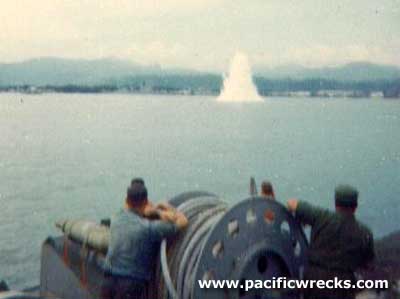|
Ship History
Built by William Cramp and Sons at Philadelphia, PA. Laid down September 19, 1890. Launched December 2, 1891. Commissioned August 1, 1893 as USS New York with Captain John Philip in command. Designated Armored Cruiser No. 2 (ARC-2).
Spanish American War
Participated in the Battle of Manila as Admiral Sampson's flagship during the Spanish-American
War. Afterwards, steamed to Yokohama and became the US Navy flagship of the Asiatic
Fleet.
World War I Service
In February,
1911 she was formerly renamed USS Saratoga. During
World War I she served with the Pacific Patrol Force,
and in December, 1917 underwent yet another name change, becoming USS
Rochester.
Following service with the Atlantic Fleet and in the
Caribbean, Rochester returned to Asiatic waters in June 1932 and patrolled
off
the Yangtze River in China.
In 1933 moved
to Cavite, and was officially decommissioned
on
April 29, 1933. Afterwards, towed to Subic
Bay and moored
off the Olongapo where she served for the next eight
years as an auxiliary power plant and machine shop for the Naval Station.
Wartime Service
During
December, 1941, as Japanese forces approached Luzon, Rochester was moved by tug boats into Subic
Bay and scuttled to prevent capture.
Shipwreck
Rochester settled on the bottom with the bow pointed upward. During July 10-22, 1967 the shipwreck was partially demolished
by Harbor Clearance Unit-1. After the demolition, Rochester rests on her side with her hull buried in the sand.
Tony Basi adds:
"About 10 of July 1967 to about the 22 of July 1967 the
outfit I was in Harbor Clearance Unit-1 began and
finished demolition on the USS New York or Rochester as she was called,
although
the reporter
who did the story said the heavy cruiser was blown up, I do not
recall him being aboard when we were making the charge and the divers
were planting the charges on the wreck. I was able to get
two shots off of the waterspout. I was not a diver I was one of
the crew on the YLLC-2 and packed the hose charges that were used. She
was too big and too tough to blow completely up, the bow was pointed
upwards and had to be pushed down to make room for a POL Buoy."
Dale Sanders made numerous
dives on the
hull between 1973 and 1978:
"Much of the superstructure
is lying apart from the hull, and said that her smokestacks are also
visible. Her guns, however, are gone, although some have been spotted
in the sandy bottom
close to the hull. During their years of exploring the Rochester, Sanders
and his fellow divers were able to recover a number of items from the
ship - brass portholes and fittings, porcelain coffee cups, and miscellaneous
smaller items. Many of these items were on display at the Subic Bay Yacht
Club."
Contribute
Information
Are you a relative or associated with any person mentioned?
Do you have photos or additional information to add?
Last Updated
December 19, 2025
|

